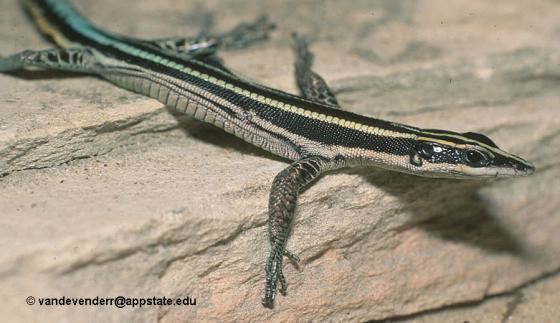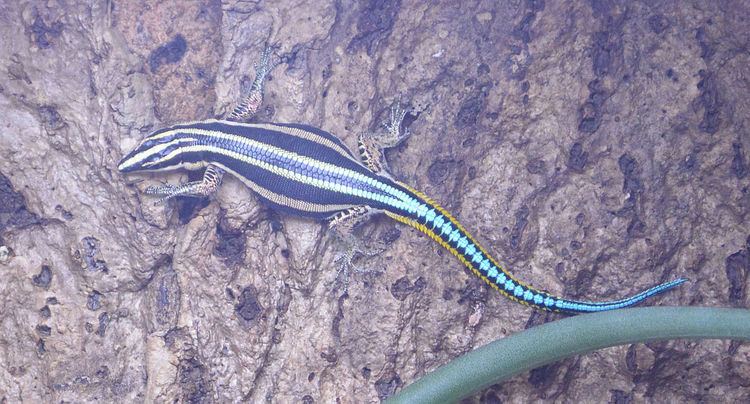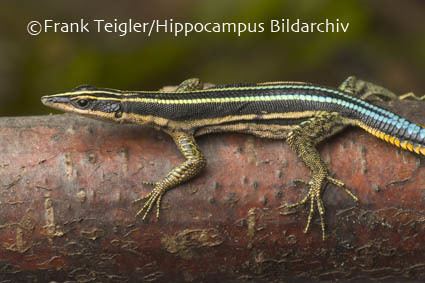Phylum Chordata Order Scaled reptiles | Class Reptilia Scientific name Holaspis Rank Genus | |
 | ||
Similar Gastropholis, Latastia, Heliobolus, Philochortus, Tropidosaura | ||
Blaue s geschwanzeidechse holaspis guentheri
Holaspis is a genus of equatorial african lacertids in the family Lacertidae.
Contents
- Blaue s geschwanzeidechse holaspis guentheri
- L zard holaspis guentheri
- Etymology
- Distribution
- Description
- Habitat and natural history
- Vivarium keeping
- Species
- References
L zard holaspis guentheri
Etymology

The New Latin word "Holaspis" is derived from the Greek words "aspis", ἀσπίς (= a buckler, or round shield) and "holos", ὅλος, ὅλως (= whole, all, complete). It refers to the head scalation with frontoparietal and occipital scales all fused.

H. guentheri is named after Albert Günther (1830-1914), a German-born zoologist at the British Museum and the latin word "laevis" means smooth.

The common names are Eastern/Western Blue-tailed Tree Lizard, Blue-tailed Gliding Lizard, Serrate-toed Tree Lizard, Sawtail Lizard and Neon Blue-tailed Tree Lizard.
Distribution

The two species have disjunct distributions. Holaspis guentheri lives in West Africa in the southern parts of Sierra Leone, Guinea, Liberia, Ghana, Togo, Benin, Nigeria, and Cameroon. In north Cameroon exist relict populations in the Guinea savanna region (30 km northeast of Tignère, 1000 m altitude). In Central Africa it can be found in Equatorial Guinea, Gabon, Central African Republic, Congo, northern and western Democratic Republic of Congo and south to northwestern Angola. This species is also known in East Africa from northwestern Tanzania (Bukoba) and southeast Uganda (Budongo Forest) (regions west of Lake Victoria).

Holaspis laevis is distributed in East Africa in northeastern and southeastern Tansania, northeastern and centraleastern Mozambique and southern Malawi.
Description

In morphology-based parsimony and compatibility analyses Arnold (1989) recognized a clade called the ‘Equatorial African group’ including Adolfus, Gastropholis, and Holaspis. In all lacertids of this clade the parietal foramen is consistently absent, the parietal scale extents to the edge of the parietal table and the postnasal scale is single. In Holaspis head and body are very depressed, frontoparietal and occipital scales are all fused to shields, the tail is depressed with lateral fringes of scales and the third and fourth toes of the forefoot are fused for nearly their entire joint. Two longitudinal rows of smooth broad band-like scales down the vertebral line of the back and on the tail. The ventral scales are smooth. The collar is composed of 9 to 15 small scales. 16 to 24 femoral pores present, more developed in males. Maximum total length in both species 129 mm, maximum snout-vent-length (SVL) 53 mm. No sexual dimorphism in SVL but males have larger heads and their tail base is wider.
Dorsally the ground colour is black. On the head from the tip of the snout to the nape of the neck there is a yellow to yellow greenish median line. On each side of the back outside the large dorsals there runs a turquoise to sky blue longitudinal stripe which fuses on the tail base. From there it travels as a clear blue stripe partly interrupted onto the tip of the tail. The pattern of the flanks differ in the two species: In H. guentheri there are two yellowish brown to greyish lines on the flanks while in H. laevis there runs only one broader yellowish brown to red brown or usually beige stripe from the tip of the snout to the hind limb. The wide tail scales on the sides are yellow to orange coloured.
The number of light or dark stripes is the only known external morphological difference between the two species. As Arnold (1989) wrote: H. guentheri: "A dark vertebral stripe on body and three dark stripes on each side". H. laevis: "A dark vertebral stripe and two dark stripes on each side".
Ventrally the lizards are yellow or orange to greenish-orange coloured, partly with a mother-of-pearl shimmer. Males are often more brightly coloured. Juveniles resemble their parents but the coloured dorsal stripes are narrower and less intensly coloured. Ventrally the juveniles are pitch-black in contrast to the adults.
Habitat and natural history
Holaspis are diurnal, arboreal, extremely agil lacertids and able to move on vertical and overhanging surfaces with body and tail pressed closely to the surface. They live on larger trees at least 15 m above the forest floor in primary forest, man-influenzed areas and even in Eucalyptus forest with smooth bark but are not found in closed forest. The serrated tail is considered as an additional tree climbing adaption to increase grip.
They are active hunters of small insects and other arthropods like ants, grasshoppers and spiders, often investigating crevices in which they also frequently hide.
The species of Holaspis are less specialized for flight than species of the agamid genus Draco or gekkonid genus Ptychozoon for example. They are unique among lacertids in being capable of gliding flight between trees up to 30 m distance. Adaptions for gliding are the flat body and tail, the fused fingers and their low body mass. Their bones are packed full of air spaces, making the lizard's skeleton feather light for gliding.
Not much is known about the reproduction in nature. More than one clutch/year is produced. Females lay two eggs under loose bark or in leaf litter. Specimen from northeastern Democratic Republic of Congo laid eggs in June and females from Nyasaland caught on 3 August held two well developed eggs.
Vivarium keeping
Holaspis species are occasionally kept as pets. But Holaspis guentheri and H. laevis are often confused in pet trade or generally named H. guentheri because H. laevis was formerly only a subspecies of H. guentheri. Nearly all Holaspis in the pet trade are H. laevis. For discrimination of the two species see "Description". Captive breeding resulted in an increase of information on the biology of Holaspis.
In the "Cologne Aquarium" a female of H. laevis from Tanzania laid one to two eggs on 14 November, 22 December, 24 February and 5 April. Only one egg hatched after 54 days of incubation. Incubation of eggs was more successfully by Kroniger & Bosch (2001). Females of H. laevis deposited eggs under the bark. Clutch almost always consisted of two eggs, rarely only one egg was laid by younger females. They produced clutches every four to six weeks during the year. Egg size at oviposition was (6.0 - 7.2) mm x (11.3 - 12.9) mm and their mass (0.30 - 0.38) g. At 29 °C the incubation time was 55 to 57 days. Hatchlings measured 21 to 24 mm in snout-vent-length and 30 to 35 mm in tail length and had a mass of 0.23 to 0.25 g. Sexual maturity is reached in 1.5 to 2 years in captivity.
Species
Two species are recognized. Formerly H. laevis was a subspecies of H. guentheri.
